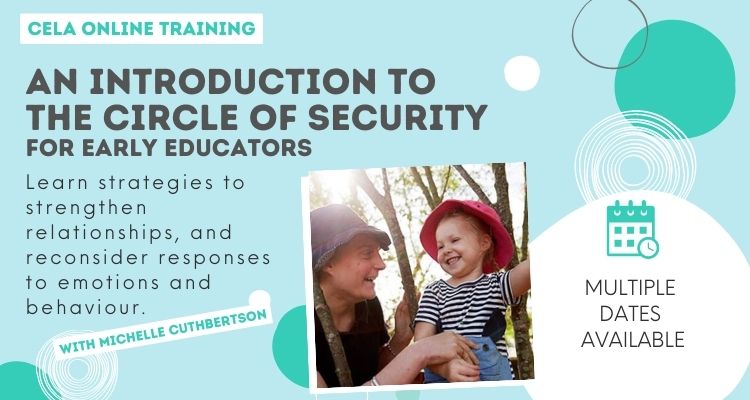Attachment is the enduring psychological connectedness in a relationship. Developmental psychologist John Bowlby, the ‘father of attachment’, said that what makes children (and all of us) feel safe and secure is a relational anchor — someone who is physically and emotionally available.
The decades of attachment research following Bowlby’s work continues to substantiate the significant role secure attachment plays in early education settings; the securely attached child exhibits a strong sense of self, increased emotional intelligence and social competence, and a smoother transition to school. They are more likely to have greater academic and social success as they mature1.
The relationship between an adult and a child is shaped by the adult, including the extent to which the child will feel, or not feel, securely attached. By applying an attachment framework to their daily practices, educators become the relational anchor children need to confidently engage in the learning environment and its developmental opportunities. A child without this secure base invests their time and energy into finding connectedness, and so, their capacity to engage in the learning environment is limited.
The educator as an attachment figure
A relationship with an educator does not replace the important relationship a child has with their primary caregiver (usually the parents). However, when the primary caregiver is physically or emotionally unavailable, children need to know they can count on another significant adult, a secondary attachment figure, to be their relational anchor.
If a child is distressed, due to the absence of their parent/s, educators may try to reassure the child that their parent ‘will soon return’. This is not enough. A child cannot suspend their need to be in a secure relationship for the whole day. What the child really needs to know is that the educator is committed to filling the relationship gap until their primary attachment person returns.
Secure attachment relationships take time and commitment. With the demands of each day, educators may find themselves focussed on getting through their tasks, meeting educational outcomes, and managing behaviours of concern. However, by attending to children’s attachment needs, we see improvements both in educator wellbeing and in the learning and developmental outcomes for children.
Reflecting on behaviour through the attachment lens
The child’s experiences with their primary caregiver provide them with a template to make sense of other relationships, including those with educators. Children who have experienced secure attachment at home have an expectation that other significant adults will also be committed to them and respond to their needs. For these children, the educator’s responsibility is, simply, to meet those expectations.
However, a child from an insecure, avoidant, or disorganised attachment background may have an expectation that adults will not meet their needs. The child’s attempts to find connection are often communicated through their behaviour. With an understanding of secure attachment, the educator will recognise this, and respond to the unmet needs. As the child begins to feel a sense of connectedness, of being understood, they no longer require the behaviour.
Even educators with positive intentions to support secure attachment may struggle at times to develop a relationship with a child, or to respond to a child’s behaviour within the attachment model. A child’s behaviour today can unknowingly trigger a discomfort in us due to our own attachment history (when many families did not have the benefit of understanding attachment theory). Once the discomfort is identified for what it is, we can reframe our thinking, override these feelings and support the child’s attachment needs.
For example, an educator may think "This behaviour is irritating. I need to ignore the child and walk away (and then I’ll be ok)". Or they can choose to reframe their thinking to “maybe this child has no other way to express their big feelings. I can choose to ignore them, or I can put aside my discomfort to be available for the child, to let them know I am here for them, to give their feelings resonance. When their emotions settle, I can help them find other ways to express their needs”.
By shifting our focus, and therefore our response, the child begins to sense “This educator is here for me, he/she gets me…. I must be worth it”
The Circle of Security™ For Educators program, grounded in 60 years of attachment research, inspires educators to consider the positive implications of an attachment framework on their daily practices. There are also opportunities for participants to identify their struggles with children who may be difficult to connect with, while considering the impact their own early experiences may have on their current relationships with children.
A child’s need for secure attachment is always there. If we put on our attachment lens, we see it clearly. As we begin to identify and meet children’s relational needs, there will be a shift from the exhaustion of trying to manage or extinguish behaviours to a calm rhythm where relationships are strengthened, educators are more confident, and have better job satisfaction, and children are more secure, and cooperative1.
References:
1. Research Spotlight at Circle of Security International
Want to know more about attachment and adult-child relationships?

Find out more
About Michelle
Michelle Cuthbertson, a licensed Circle of Security™ facilitator, has over 40 years’ experience working with children, families, and educators. As well as facilitating workshops for CELA, Michelle operates her own training and consultancy business focussing on supporting and empowering educators and families to enrich and strengthen their relationships with children.